A well-designed plant privacy fence can increase your property value by up to 20% while creating an eco-friendly barrier that attracts beneficial wildlife. You’ll find that living screens offer advantages traditional fencing can’t match: natural sound buffering, seasonal interest, and improved air quality. Whether you’re looking to block unsightly views or create an intimate outdoor space, these nine plant-based solutions will transform your yard into a secluded sanctuary.
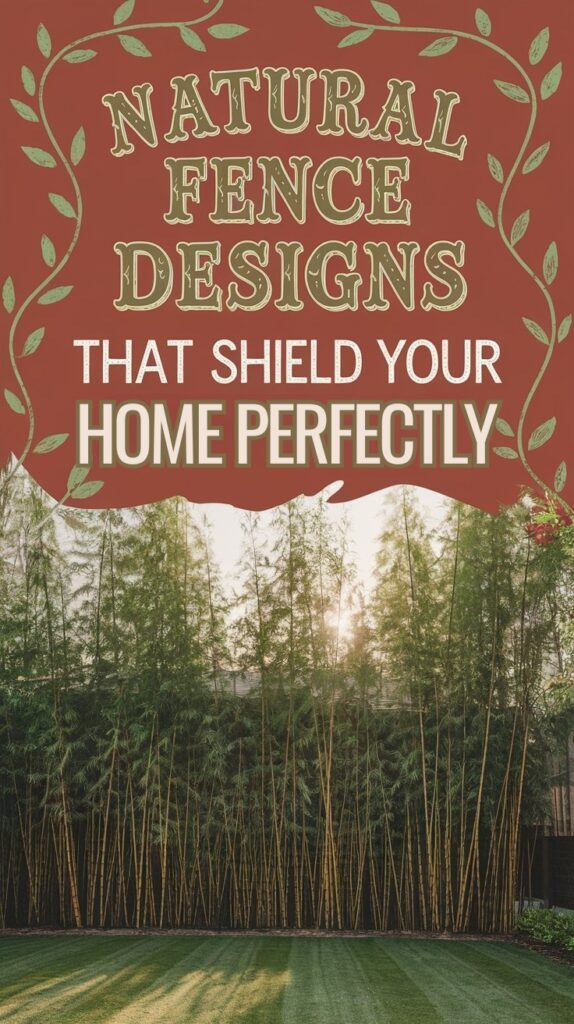
Contents
- 1 Fast-Growing Bamboo Screening
- 2 Layered Evergreen Hedges
- 3 Flowering Vines on Trellises
- 4 Mixed Border Privacy Plantings
- 5 Living Walls With Ornamental Grasses
- 6 Columnar Trees for Vertical Screening
- 7 Container Garden Privacy Solutions
- 8 Four-Season Screen Gardens
- 9 Natural Fence Combinations With Shrubs
Fast-Growing Bamboo Screening

Bamboo screening offers one of the fastest natural privacy solutions available, with certain species capable of growing several feet per year. These towering grass varieties create dense, elegant green walls with their distinctive vertical canes and graceful, swaying foliage.
Running bamboo varieties spread quickly through underground rhizomes, while clumping bamboo maintains a more contained growth pattern, making it ideal for controlled privacy screens.
- Light: Prefers full sun to partial shade; minimum 4-6 hours direct sunlight daily
- Soil: Well-draining, slightly acidic soil (pH 6.0-6.5)
- Water: Regular watering, keeping soil consistently moist but not waterlogged
- Temperature: Most varieties thrive in USDA zones 7-10
- Spacing: 3-5 feet apart for running bamboo; 5-8 feet for clumping varieties
- Growth Rate: 3-5 feet per year depending on species
- Height: Ranges from 10-50 feet depending on variety
Regular maintenance is crucial for bamboo screening to remain effective and contained. Trim dead or yellowing canes at ground level during spring, and remove any shoots growing outside designated areas.
For running bamboo varieties, install root barriers at least 2-3 feet deep around the planting area to prevent unwanted spread. Apply a layer of mulch annually to retain moisture and suppress weeds, and fertilize with high-nitrogen fertilizer during the growing season to promote robust growth.
Layered Evergreen Hedges

Layered evergreen hedges create a sophisticated, multi-dimensional privacy screen by combining different heights, textures, and shades of green plants. This approach typically features taller evergreens like Thuja or Leyland Cypress in the back, medium-sized shrubs like Holly or Boxwood in the middle, and lower-growing evergreens like Japanese Yew in the front.
The varied depths not only provide complete privacy but also create visual interest throughout the year while serving as an effective windbreak and noise buffer.
- Light: Most evergreen hedging plants prefer full sun to partial shade, requiring at least 6 hours of direct sunlight daily.
- Soil: Well-draining, slightly acidic soil with pH between 6.0-7.0.
- Water: Regular watering during establishment; once established, moderate watering during dry spells.
- Spacing: Plant spacing varies by species, typically 3-8 feet apart depending on mature size.
- Climate: Most evergreen hedges thrive in USDA zones 4-8.
- Depth: Allow 3-6 feet of planting depth for proper root development.
Regular maintenance is crucial for keeping layered evergreen hedges healthy and aesthetically pleasing. Trim each layer separately during the growing season to maintain distinct heights and prevent the faster-growing plants from overwhelming slower-growing varieties.
Remove dead or yellowing branches promptly to prevent disease spread, and apply a layer of mulch around the base of the plants in spring and fall while keeping it away from the trunks. Fertilize in early spring with a balanced, slow-release fertilizer to promote steady growth across all layers.
Flowering Vines on Trellises
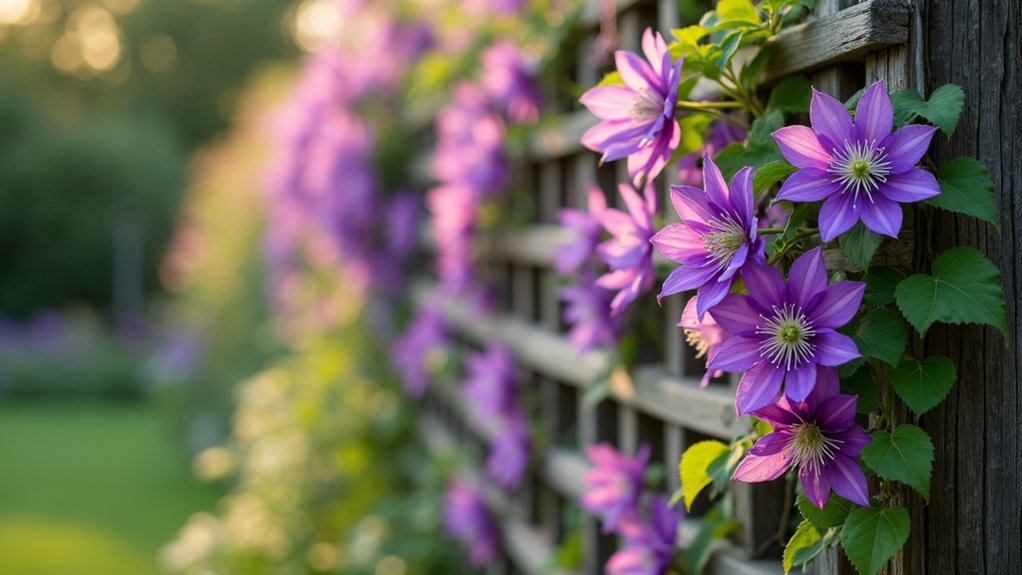
Flowering vines trained on trellises create a stunning living privacy screen that combines the structural support of lattice or wire frames with the natural beauty of climbing plants.
These vertical gardens feature cascading blooms and lush foliage that can quickly cover large areas, offering both beauty and functionality. Popular options include clematis, climbing roses, jasmine, and morning glories, each providing unique flower colors, fragrances, and seasonal interest while effectively blocking unwanted views.
- Light Requirements: Most flowering vines need 6-8 hours of direct sunlight daily; some varieties tolerate partial shade
- Soil Needs: Well-draining, rich organic soil with pH between 6.0-7.0
- Water Requirements: Regular watering to maintain consistently moist but not waterlogged soil
- Spacing: Plant 3-6 feet apart, depending on variety
- Climate: Select vines suited to your specific hardiness zone
- Support Structure: Strong trellises, secured firmly in ground, spaced 4-6 inches from walls or fences
Regular maintenance is crucial for keeping flowering vines on trellises looking their best and preventing them from becoming unruly.
Prune dead or damaged stems throughout the growing season, and train new growth by gently weaving it through the trellis or securing it with plant ties.
Perform major pruning in late winter or early spring before new growth begins, removing old woody stems and shaping the plant.
Apply a layer of mulch around the base to retain moisture and suppress weeds, but keep it away from the main stems to prevent rot.
Mixed Border Privacy Plantings
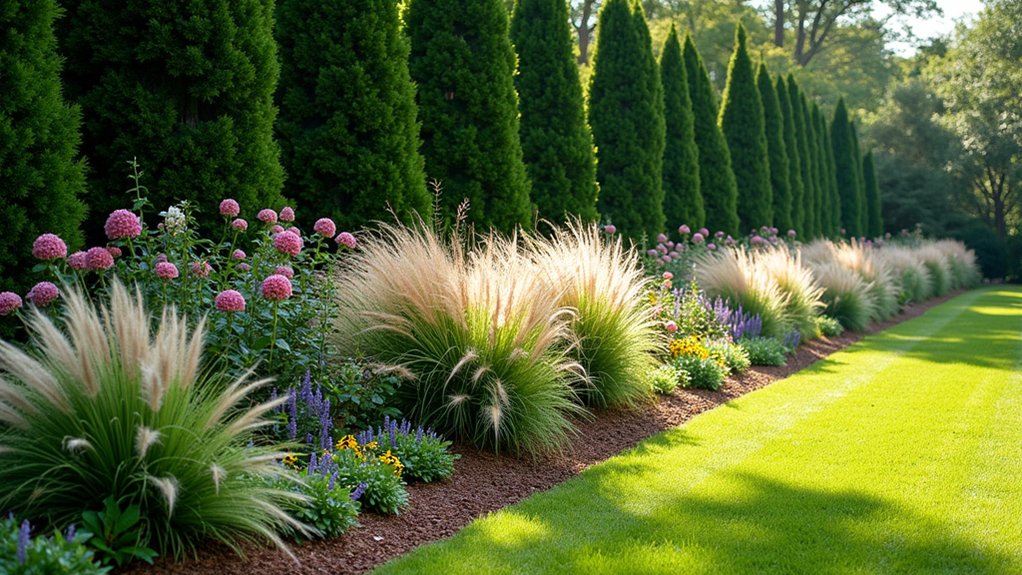
Mixed border privacy plantings create a natural, layered screen by combining various plant types at different heights, textures, and growth habits. This landscaping approach typically includes tall evergreen trees or shrubs as the backbone, medium-height flowering shrubs for the middle layer, and lower-growing perennials or ornamental grasses for the foreground.
The diverse plant selection offers year-round privacy while providing visual interest through changing seasons, colors, and blooms.
- Light requirements: Most mixed borders need full to partial sun (6+ hours daily), though some shade-tolerant varieties can be incorporated on darker sides.
- Soil conditions: Well-draining, fertile soil with pH between 6.0-7.0.
- Water needs: Regular watering during establishment; varies by plant selection afterward.
- Spacing: Plants should be positioned according to mature sizes, typically 2-4 feet apart for shrubs.
- Climate zones: Select plants suited to local hardiness zone.
- Depth: Border width of 4-8 feet provides optimal layering opportunity.
Regular maintenance keeps mixed border privacy plantings looking their best and functioning effectively as a screen.
Prune deciduous shrubs annually to maintain shape and remove dead branches, while limiting evergreen trimming to light shaping.
Apply a 2-3 inch layer of mulch around plants in spring, refresh soil nutrients with compost annually, and monitor for gaps in the privacy screen that may need filling.
Remove weeds promptly to prevent competition for resources, and adjust watering schedules based on rainfall and seasonal changes.
Living Walls With Ornamental Grasses
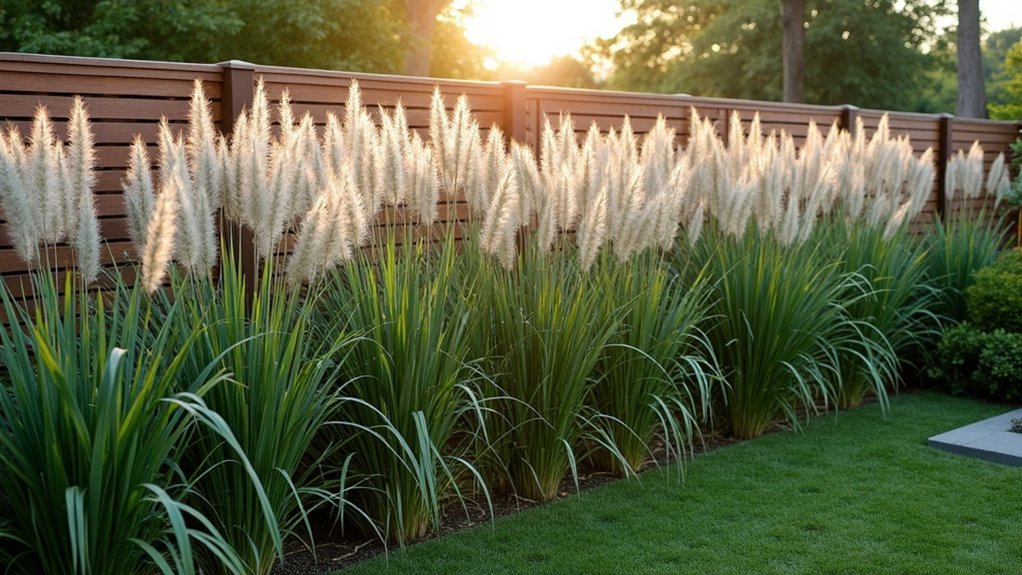
Living walls with ornamental grasses create a natural, flowing privacy screen that combines different heights, textures, and colors for year-round interest.
These versatile grasses, such as feather reed grass, maiden grass, and switchgrass, can reach heights of 3-8 feet, forming dense clumps that sway gracefully in the breeze while effectively blocking unwanted views.
When planted in rows or masses, these grasses create a sophisticated, contemporary look that serves both aesthetic and practical purposes.
Growing Conditions:
- Full sun to partial shade, with most varieties preferring 6+ hours of direct sunlight
- Well-draining soil with moderate fertility
- Regular watering during establishment; drought-tolerant once established
- Spacing of 2-3 feet between plants for optimal privacy coverage
- USDA hardiness zones 4-9 for most common varieties
- Neutral soil pH between 6.0-7.0
Regular maintenance ensures ornamental grasses remain attractive and effective as privacy screens.
Cut back grasses to 6-8 inches above ground in late winter or early spring before new growth emerges.
Remove dead foliage throughout the growing season and divide clumps every 3-4 years when they become overcrowded or show decreased vigor.
Apply a slow-release fertilizer in spring, and maintain a 2-3 inch layer of mulch around plants to suppress weeds and retain moisture.
Columnar Trees for Vertical Screening
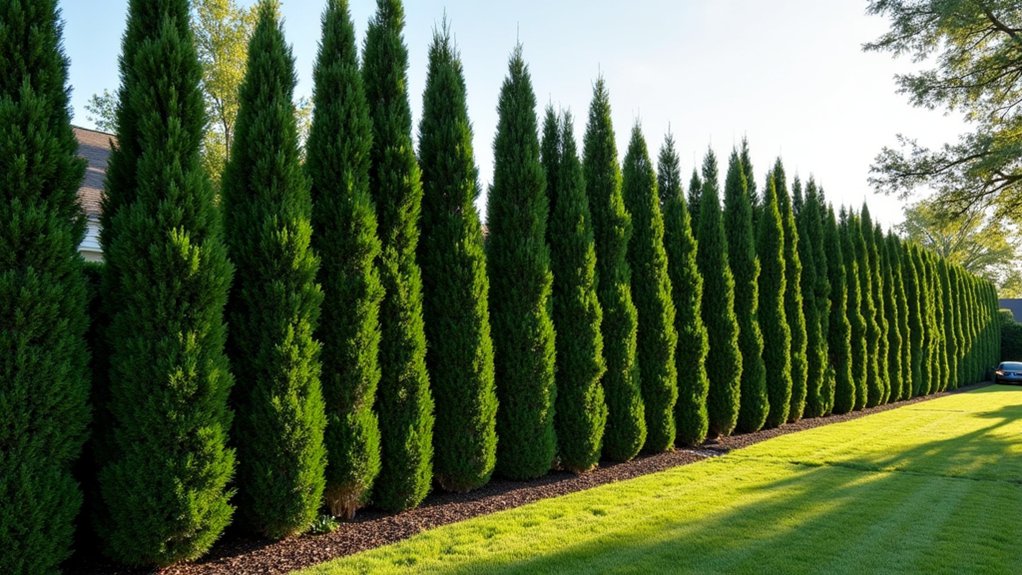
Columnar trees provide an elegant natural privacy solution, growing tall and narrow with a distinctive upright form that creates effective vertical screening without taking up much horizontal space.
These architectural plants maintain a slim profile throughout their growth, typically reaching heights of 20-40 feet while staying just 4-8 feet wide, making them perfect for property boundaries and tight spaces.
Popular varieties include Italian Cypress, Lombardy Poplar, and Sky Pencil Holly, each offering dense foliage that creates living walls of greenery.
- Light Requirements: Full sun to partial shade, minimum 6 hours direct sunlight daily
- Soil Needs: Well-draining, moderately fertile soil with pH 6.0-7.0
- Water Requirements: Regular watering during establishment; moderate once established
- Spacing: Plant 4-8 feet apart, depending on variety
- Hardiness: Varies by species, typically USDA zones 4-9
- Growth Rate: Moderate to fast, typically 1-3 feet per year
Regular pruning is essential to maintain the columnar shape and prevent spreading, with early spring being the optimal time for major trimming before new growth begins.
Remove any damaged or crossing branches, and shape the sides as needed to maintain the narrow form.
Apply a slow-release fertilizer in spring, and maintain a 2-3 inch layer of mulch around the base, keeping it away from the trunk to prevent moisture-related issues.
Monitor for signs of disease or pest infestation, particularly during periods of high humidity or stress.
Container Garden Privacy Solutions
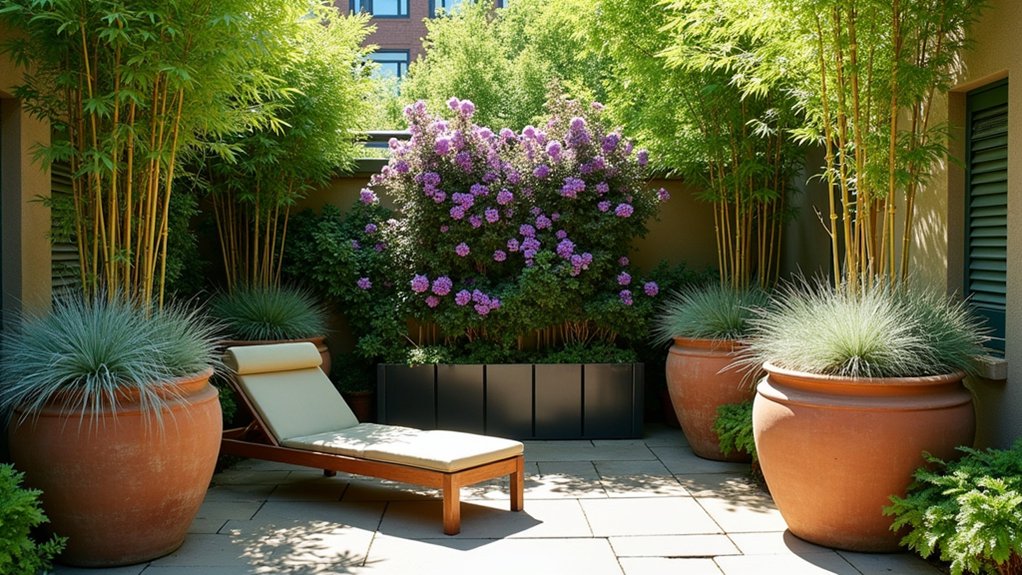
Container garden privacy solutions offer a versatile and mobile approach to creating natural screening using potted plants. Large containers filled with tall ornamental grasses, climbing vines on trellises, or columnar evergreens can be strategically arranged to block unwanted views and create intimate outdoor spaces.
This method is particularly valuable for renters, deck and patio owners, or those seeking flexibility in their privacy screening layout.
- Light Requirements: Most privacy plants in containers need full to partial sun (6-8 hours daily)
- Water Needs: Regular watering required, often daily in hot weather due to container constraints
- Soil Type: Well-draining potting mix specifically formulated for containers
- Container Size: Minimum 24-inch diameter for most privacy plants
- Spacing: Containers placed 2-3 feet apart for optimal coverage
- Temperature: Protected from extreme temperature fluctuations
- Drainage: Containers must have adequate drainage holes
Maintaining container garden privacy screens requires consistent monitoring of soil moisture, as containers dry out faster than ground plantings.
Regular fertilization every 4-6 weeks during growing season compensates for limited soil volume. Prune plants to maintain desired height and fullness, rotate containers periodically for even growth, and inspect for signs of pest infestation or disease.
Winter protection may be necessary for less hardy specimens, either by moving containers to sheltered locations or providing appropriate insulation.
Four-Season Screen Gardens
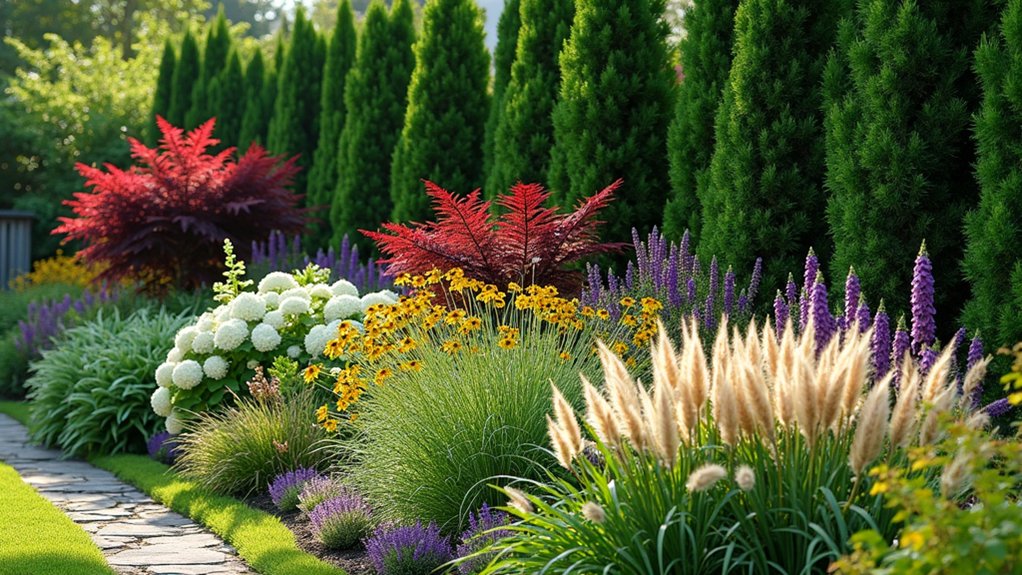
Four-season screen gardens create year-round privacy by combining various plants that maintain visual interest throughout all seasons.
These layered gardens typically feature evergreen trees or shrubs as the backbone, deciduous plants for seasonal color, ornamental grasses for texture, and flowering perennials for added vibrancy. The design ensures that as some plants go dormant, others take center stage, maintaining consistent coverage and aesthetic appeal from winter through fall.
- Light Requirements: Mix of full sun to partial shade, depending on selected plants
- Soil Type: Well-draining, rich organic soil with pH 6.0-7.0
- Water Needs: Moderate, with deep watering for established plants
- Spacing: Plant 2-4 feet apart for shrubs, closer for perennials
- Climate Zones: Most effective in zones 4-9
- Height Range: Varies from 3-15 feet, depending on plant selection
Regular maintenance is crucial for four-season screen gardens to maintain their effectiveness and appearance.
Prune evergreens in early spring before new growth emerges, and shape deciduous plants after flowering.
Remove dead foliage from perennials in late winter, and divide overcrowded plants every 3-4 years to maintain healthy growth.
Apply a fresh layer of mulch annually to suppress weeds and retain moisture, and fertilize plants according to their individual needs during the growing season.
Natural Fence Combinations With Shrubs
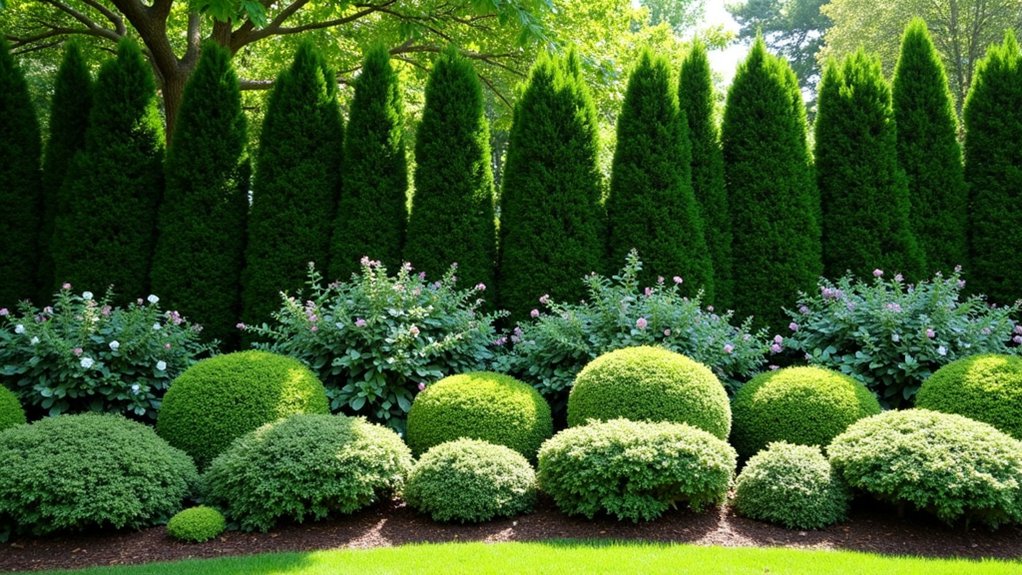
Creating natural fence combinations with shrubs offers a multi-layered approach to privacy screening by mixing different shrub varieties for depth, texture, and visual interest.
Combining tall, medium, and low-growing shrubs creates a lush, living wall that appears more natural than a single-variety hedge. Strategic placement of evergreen shrubs as the backbone, coupled with flowering or decorative varieties, ensures year-round coverage while providing seasonal color changes and wildlife habitat.
- Light Requirements: Most privacy shrub combinations need full to partial sun (6-8 hours daily)
- Soil Needs: Well-draining, slightly acidic soil (pH 6.0-7.0)
- Water Requirements: Regular watering during establishment; moderate once established
- Spacing: Plant 3-6 feet apart depending on shrub varieties
- Climate: Hardy in USDA zones 4-9 (varies by specific shrub selection)
- Growth Rate: Mix of fast and slow-growing varieties for quicker coverage
Regular maintenance is crucial for keeping shrub combinations healthy and attractive.
Prune each variety according to its specific requirements and flowering cycle, typically in late winter or early spring before new growth begins.
Remove dead or crossing branches to maintain good air circulation, and apply a layer of mulch around the base of shrubs to retain moisture and suppress weeds.
Fertilize in spring with a balanced, slow-release fertilizer, and monitor for signs of pests or diseases specific to each shrub variety.
